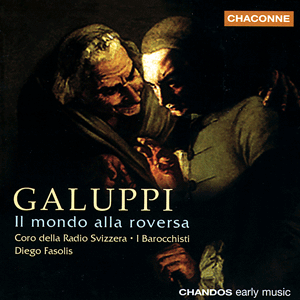Galuppi wrote around 100 operas, the first at
the age of 16, as well as oratorios, choral music and harpsichord concertos.
Born in Venice he travelled to London (1751) and St Petersburg (1766-68)
and, according to Dr. Charles Burney, a scholar who travelled extensively
in Italy during the 1770s, he had more influence on English music than
any other Italian. More recently the renowned musicologist Prof. Edward
Dent (1876-1957) has suggested that while Galuppi’s melody was attractive
but not strikingly original; "he had a firmer grasp of harmony,
rhythm, and orchestration than most of his contemporaries".
Galuppi is important in operatic history as
the pioneer of the finalé, joining movements into a concerted
whole in which the dramatic action reaches a crucial situation and is
then developed. His most successful operas were written, as here, with
the Venetian playwright Carlo Goldoni who had reformed the original
‘comedia dell'arte’ and developed this into ‘opera buffe’, thus bringing
comedy into the opera house. His texts provided simplicity and directness
with reduction of dialogue, more musical numbers, including arias, lovers’
duets and big final ensembles. Galuppi set the dialogue words with secco
recitative. In combination Goldoni and Galuppi were said to have invented
‘opere buffe’.
First staged in Venice in the autumn of 1750, Il
Mondo alla Roversa with an alternative title Osia Le donne
che commando or Women in Command gives the clue of the plot,
which concerns an island in the Antipodes governed by a council of women.
Act 1 opens with the three members of the council, Tulia (sop), Aurora
(mezz) and Cintia (mezz) demonstrating their power over their spineless
lovers, Giacinto (bar), Graziosino (bar), and Rinaldino (sop). The women
fear the men will, being physically stronger, overthrow them. Meanwhile
the men, in fact, are happy to be in a state of subjection to feminine
wiles. Aurora fancies adding Giacinto, in love with Cintra, to her tally
of lovers, leading to a three sided confrontation.
In Act 2 the women decide to move towards a monarchical
government but none of them is agreed by a majority because "no
lady will consent to be subject to another" and each protagonist
ponders how to grasp the reins of power to herself. While each lady
plots, some willing men arrive by boat albeit that one, Ferromonte (ten)
is not as willing as the rest and believes that the ‘chains of love’
should be avoided. In the final and shortest Act, Rinaldino, convinced
by Ferromonte of the necessity to overthrow female rule, saves the life
of Tulia. Cintia, whose thirst for power has driven her to propose the
murder of her rivals, has to humble herself before her lover, Giacinto.
To Ferromonte’s great satisfaction all now accept the inevitable conclusion
that ‘women in command make for a topsy-turvy world’ that can never
last.
In the Chandos issue, Act 1 fits neatly on to one disc;
Acts 2 & 3 on to the second. The recording, made in the auditorium
of the Stelio Mulo in Lugano, features the choir of Swiss Radio with
the ensemble of I Barocchisti. The foregoing will reassure Baroque specialists
as to the approach, as will the fact that all the soloists are experienced
in this specialist field. That means flexible, lightish voices using
little vibrato allied to an ability to hold an even line in the recitatives
and not let dramatic impact sag in the arias and duets. The challenge
in casting the singers is to enable the listener to recognise which
character is singing by the timbre of voice. Both baritones have wide
ranges of tone and colour but there are times when the ear is confused
as to which character is singing. At first I wondered if Fulvio Bettini
as Giacinto was more suitable for Mozart’s Figaro. But no, as
a Bach cantata specialist he can handle the demands of the music and
brings lively runs and characterisation to his role as does the lighter
voiced Furio Zanasi as Graziosini. The tenor, Davide Livermore as Ferromonte,
has an edge to his voice, not inappropriate here, that indicates his
Mozartain operatic work.
Of the women singers, the two mezzos are easily differentiated;
the Cintia of Mya Fracassini being more towards the contralto end of
that vocal register, whilst Rosa Dominguez has a distinctly lighter
voice. Both sing well and with appropriate vocal and dramatic intensity
in arias and duets, and with good line in the recitatives. Of the sopranos,
Marinella Pennicchi as Tulia, has a pure toned light voice with a secure
top and trill, and is a delight to listen to. I couldn’t say that of
Lia Serafini as Rinaldino. I found raw patches in the middle of her
voice that didn’t lie easily on my ear; others may react otherwise.
Try CD1 tk19-20.
It is a pleasure to report that the orchestra and chorus
play a full and vital part under the direction of Diego Fasolis. The
recording is up to Chandos’s renowned high standards with a well-balanced
sound in an airy natural acoustic. When so many issues of operatic music
from this period involve recording of live performances, complete with
coughs, stage movements, inappropriate applause, etc. disturbing the
enjoyment. It is therefore particularly pleasing to welcome this fine
recording of a rare work by a composer who made a distinct contribution
to the evolution of opera.
The accompanying booklet contains brief historical
notes, a synopsis, biographies of participants and a libretto with English
translation.
Robert J Farr


